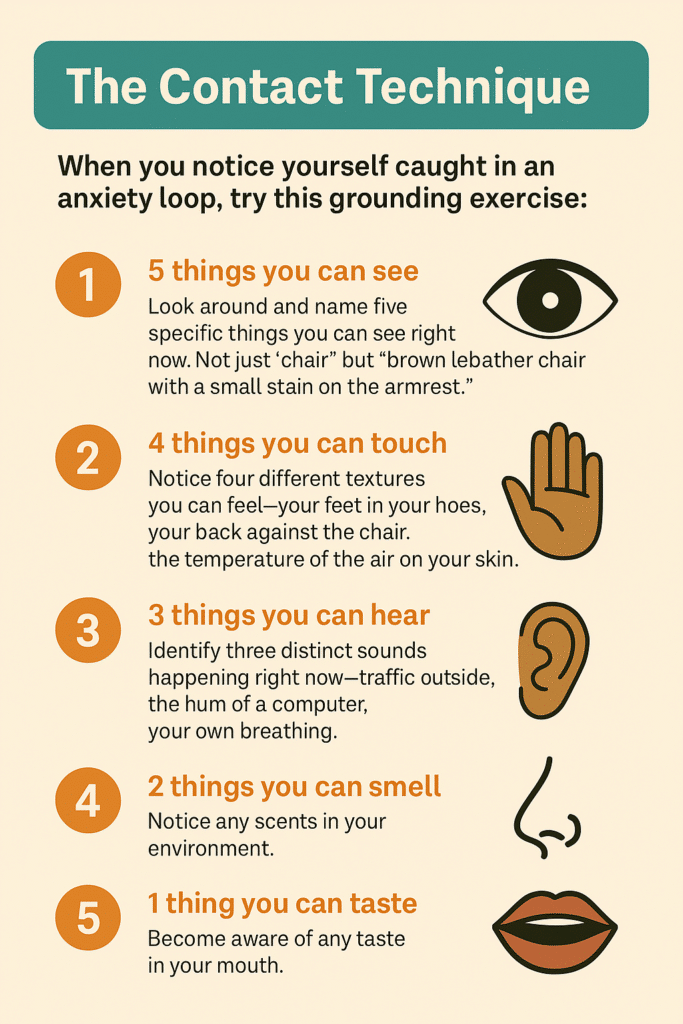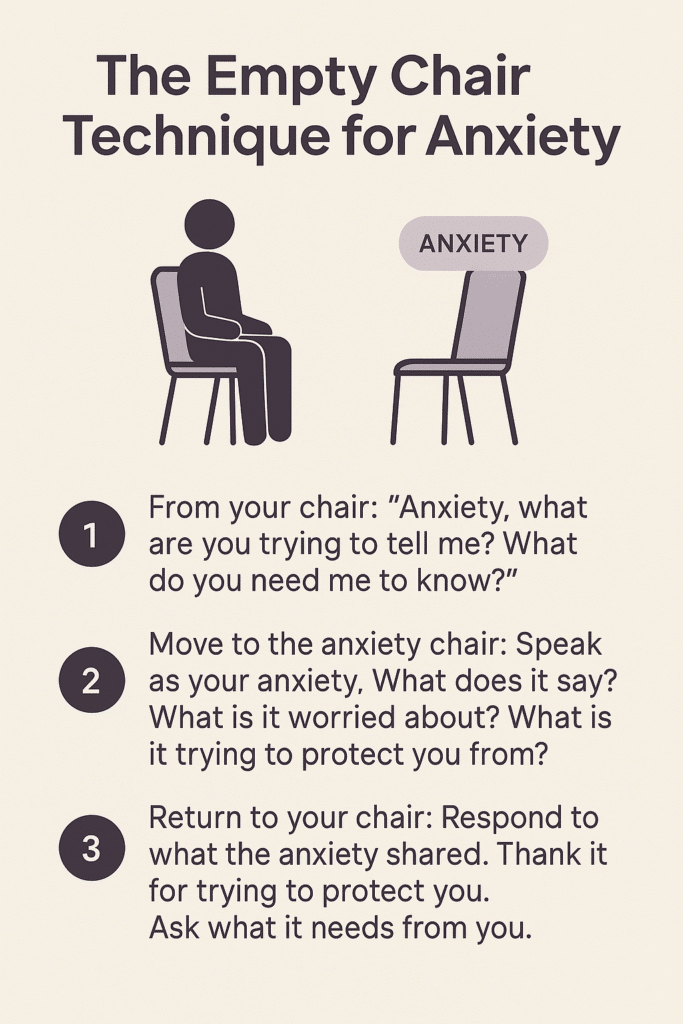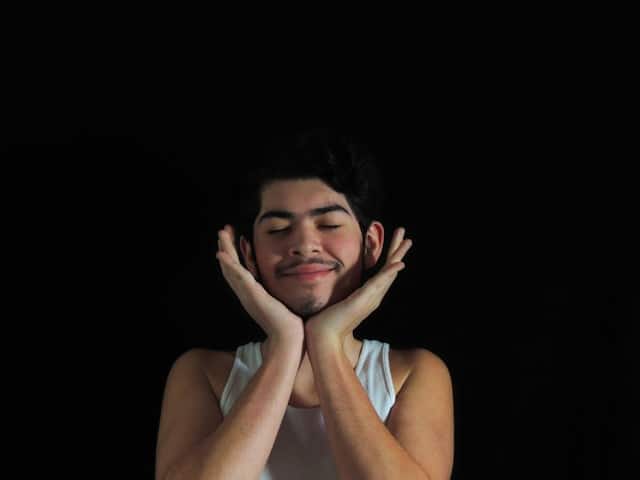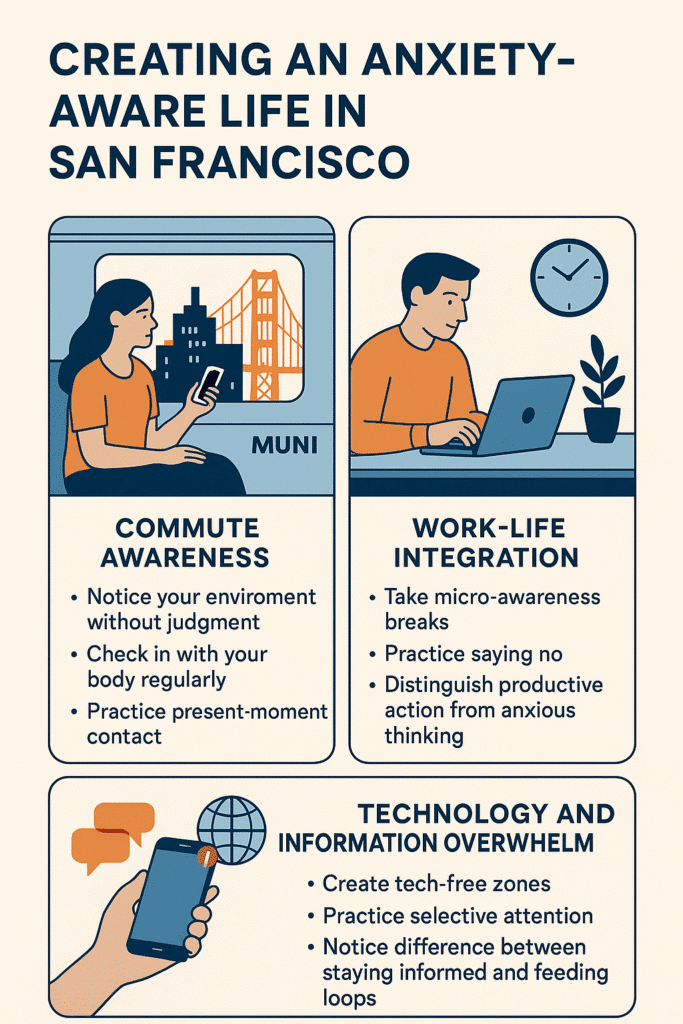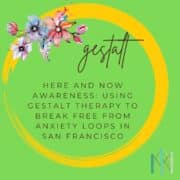
It’s 3 AM and you’re lying in bed, mind spinning with tomorrow’s presentation, next month’s rent, and that conversation from last week that you can’t stop replaying. Your body is tense, your breathing is shallow, and despite being exhausted, sleep feels impossible. You’re caught in what feels like an endless anxiety loop. Your mind is jumping between past regrets and future worries while your present moment gets lost in the chaos.
If this sounds familiar, you’re not alone. In San Francisco’s fast-paced, high-pressure environment, anxiety loops are incredibly common. The constant stimulation, competitive culture, and never-ending stream of information can keep your nervous system in a state of chronic activation, making it nearly impossible to find peace in the present moment.
Gestalt therapy offers a powerful antidote to anxiety loops through its emphasis on here-and-now awareness. Rather than trying to think your way out of anxiety, Gestalt therapy helps you develop the capacity to be fully present with whatever is happening right now … including the anxiety itself.
What Are Anxiety Loops and Why Do They Happen?
Anxiety loops are repetitive thought patterns that keep you stuck cycling between worry, fear, and mental problem-solving. Your mind becomes convinced that if it just thinks hard enough, plans thoroughly enough, or analyzes deeply enough, it can eliminate uncertainty and guarantee safety.
But here’s the paradox: the more you try to think your way out of anxiety, the more anxious you become. This happens because:
- Your mind conflates thinking with action. When you’re mentally rehearsing worst-case scenarios or trying to solve problems that haven’t happened yet, your nervous system responds as if these imagined threats are actually occurring right now.
- Anxiety feeds on the unknown. The more you try to control or predict the future, the more aware you become of everything you can’t control, which increases anxiety.
- Your body stays activated. While your mind is busy in the past or future, your body remains tense and vigilant, never getting the signal that it’s safe to relax.
- You lose touch with your actual experience. Caught up in mental loops, you miss the information your body, emotions, and intuition are trying to give you about what you actually need in this moment.
The Gestalt Approach to Anxiety: Present-Moment Awareness
Gestalt therapy views anxiety not as a problem to be solved but as energy that needs to be experienced and integrated. Rather than trying to eliminate anxious thoughts, Gestalt therapy helps you develop a different relationship with your anxiety—one based on awareness, acceptance, and contact with the present moment.
The foundation of this approach is the concept of here-and-now awareness—the ability to be fully present with whatever is happening in your immediate experience without judgment or the need to change it.
Core Gestalt Principles for Working with Anxiety
Contact and Awareness
In Gestalt therapy, contact refers to your ability to be in authentic relationship with your environment, others, and yourself. When you’re caught in anxiety loops, you lose contact with the present moment and become absorbed in mental constructions about the past or future.
Awareness is the foundation of contact. It’s the ability to notice what’s happening in your body, emotions, thoughts, and environment without immediately trying to change or fix it.
The Paradoxical Theory of Change
One of Gestalt therapy’s most powerful concepts is the paradoxical theory of change: change happens not through trying to be different, but through fully experiencing what is. When applied to anxiety, this means that relief comes not from fighting anxious thoughts but from being present with the anxiety itself.
Figure and Ground
In Gestalt therapy, figure refers to what’s in the foreground of your awareness, while ground is the background context. When you’re anxious, catastrophic thoughts become the figure while your actual present-moment experience becomes ground. Gestalt therapy helps you shift this dynamic, bringing your immediate sensory experience into the foreground.
Gestalt Techniques for Breaking Free from Anxiety Loops
The Contact Technique
When you notice yourself caught in an anxiety loop, try this grounding exercise:
5 things you can see: Look around and name five specific things you can see right now. Not just “chair” but “brown leather chair with a small stain on the armrest.”
4 things you can touch: Notice four different textures you can feel—your feet in your shoes, your back against the chair, the temperature of the air on your skin.
3 things you can hear: Identify three distinct sounds happening right now—traffic outside, the hum of a computer, your own breathing.
2 things you can smell: Notice any scents in your environment.
1 thing you can taste: Become aware of any taste in your mouth.
This technique helps you move from mental loops back into sensory contact with your immediate environment.
The Empty Chair Technique for Anxiety
Set up two chairs facing each other. Sit in one chair and imagine your anxiety sitting in the other chair. Now have a conversation:
From your chair: “Anxiety, what are you trying to tell me? What do you need me to know?”
Move to the anxiety chair: Speak as your anxiety. What does it say? What is it worried about? What is it trying to protect you from?
Return to your chair: Respond to what the anxiety shared. Thank it for trying to protect you. Ask what it needs from you.
This technique helps you develop a relationship with your anxiety rather than being consumed by it.
The Awareness Continuum
This foundational Gestalt technique involves continuously tracking your present-moment experience:
“Right now I’m aware of… tension in my shoulders.” “Now I’m aware of… my breathing getting faster.” “Now I’m aware of… the thought ‘I should be doing something productive.'” “Now I’m aware of… judgment about having that thought.” “Now I’m aware of… the sound of traffic outside.”
Practice this for 5-10 minutes, simply noticing what comes into your awareness without trying to change anything.
Body Scanning for Anxiety
Anxiety often manifests as physical tension or activation. Try this body-based approach:
- Start at the top of your head and slowly scan down through your body, noticing areas of tension, activation, or numbness.
- When you find an area of tension, breathe into that area and notice what happens. Does the tension have a shape, color, or texture?
- Ask the tension: “What do you need right now?” Listen for the response without judgment.
- Experiment with movement: Gently stretch, shake, or move the tense area. Notice what feels good.
Working with Specific Anxiety Patterns
Catastrophic Thinking
When your mind is spinning through worst-case scenarios:
- Notice the pattern: “I’m catastrophizing right now.”
- Ground in reality: “What is actually happening right now?” (Usually, you’re safe, sitting somewhere, thinking.)
- Differentiate past, present, and future: “This worry is about something that might happen. Right now, I am okay.”
- Return to your senses: Use the contact technique to reconnect with your immediate environment.
Perfectionism and Control
When anxiety is driven by the need to control outcomes:
- Identify what you can actually control: Your actions, responses, and choices in this moment.
- Practice the “good enough” experiment: Deliberately do something imperfectly and notice what happens.
- Explore the fear underneath: What are you afraid will happen if you’re not perfect or in control?
Social Anxiety
When anxiety arises in social situations:
- Focus on contact: Instead of monitoring how you’re being perceived, focus on actually seeing and hearing the other person.
- Notice projection: Are you assuming you know what others are thinking? Come back to what you actually observe.
- Ground in your body: Feel your feet on the floor, your breathing, your physical presence in the space.
Creating an Anxiety-Aware Life in San Francisco
Living in San Francisco presents unique challenges for anxiety management. The city’s intensity, pace, and pressure can easily trigger anxiety loops. Here’s how to apply Gestalt principles to daily life:
Commute Awareness
Whether you’re on Muni, stuck in traffic, or walking through crowded streets, use your commute as awareness practice:
- Notice your environment without judgment—the sounds, sights, and energy around you.
- Check in with your body regularly. Are you holding tension? Rushing? Bracing against the crowd?
- Practice present-moment contact instead of mentally preparing for your destination.
Work-Life Integration
In San Francisco’s demanding work culture:
- Take micro-awareness breaks: Set reminders to pause and notice what’s happening in your body throughout the day.
- Practice saying no: When you notice anxiety rising from overcommitment, experiment with setting boundaries.
- Distinguish between productive action and anxious spinning: Ask yourself, “Is this thinking leading to action or just creating more anxiety?”
Technology and Information Overwhelm
In our hyper-connected world:
- Create tech-free zones: Designate times and spaces where you’re not consuming information.
- Practice selective attention: Instead of trying to stay informed about everything, choose what deserves your attention.
- Notice the difference between staying informed and feeding anxiety loops.
The Gift of Anxiety: What Your Worry Might Be Trying to Tell You
From a Gestalt perspective, anxiety often carries important information about your needs, values, and boundaries. When you can be present with your anxiety rather than fighting it, you might discover that it’s trying to tell you:
- You need more rest or downtime
- A situation doesn’t feel safe or aligned with your values
- You’re taking on too much responsibility
- You need more support or connection
- You’re not honoring your own needs and limits
- You’re living according to others’ expectations rather than your own authentic desires
Building a Sustainable Relationship with Anxiety
The goal of Gestalt therapy isn’t to eliminate anxiety—it’s to help you develop a sustainable relationship with it. This means:
- Recognizing anxiety as information rather than something to be feared or eliminated.
- Developing the capacity to be present with uncomfortable emotions without being overwhelmed by them.
- Learning to distinguish between anxiety that’s calling for action and anxiety that’s just mental noise.
- Building tolerance for uncertainty and imperfection.
- Creating space for both productivity and rest, action and reflection.
Here-and-now awareness isn’t about achieving a state of constant calm—it’s about developing the capacity to be present with whatever is arising, including anxiety, in a way that allows you to respond rather than react.
If you’re ready to break free from anxiety loops and develop a more present, grounded relationship with your inner experience, Gestalt therapy offers a powerful path forward. The present moment is always available to you, and within it lies the peace and clarity you’ve been seeking.
When to Seek Professional Help
While these techniques can be powerful tools for managing anxiety, professional support may be needed when:
- Anxiety loops are significantly impacting your ability to work, sleep, or maintain relationships
- You find yourself avoiding important activities or places due to anxiety
- Anxiety is accompanied by panic attacks, agoraphobia, or other severe symptoms
- You’re using substances to manage anxiety
- You feel completely unable to be present or ground yourself despite trying these techniques.
Gestalt Therapy for Anxiety in the Bay Area
A Gestalt therapist can help you:
- Develop personalized awareness practices that work with your specific anxiety patterns and lifestyle.
- Explore the underlying needs that your anxiety might be trying to communicate.
- Practice present-moment contact in a safe, supportive relationship.
- Integrate body-based techniques for managing anxiety activation.
- Work through any trauma or past experiences that might be contributing to chronic anxiety.
- Develop sustainable self-care practices that honor both your need for achievement and your need for rest.
Working with a Gestalt Therapist in San Francisco
The Bay Area is home to many skilled Gestalt therapists who understand the unique pressures of living and working in this dynamic region. At Center for Mindful Therapy, many of our therapists are trained in:
- Present-moment awareness techniques for anxiety management
- Body-based approaches to working with anxiety and trauma
- Culturally responsive care for diverse communities
- Integration of mindfulness and Gestalt principles
- Support for high-achieving individuals navigating burnout and perfectionism
You don’t have to stay stuck in anxiety loops. Browse our California therapist directory or contact us to today find a Gestalt therapist who can support you in developing the awareness and presence that will transform your relationship with anxiety.

